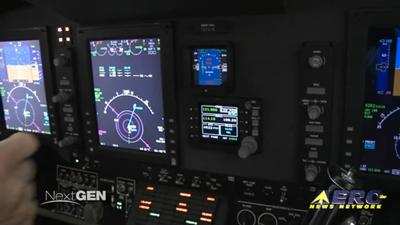'Benefits Analysis of Space-Based ADS-B' Looks At How The System Will Meet Predicted Safety Challenges Over 20 Years
Flight Safety Foundation has released the study "Benefits Analysis of Space-Based ADS-B", investigating the application of space-based automatic dependent surveillance-broadcast (ADS-B) networks to meet the predicted safety challenges of air traffic growth over the next 20 years.

The study also assesses how space-based ADS-B can enhance the world's aviation network - both the systems and industry - by introducing a near-real-time flight surveillance capability that provides 100 percent global coverage.
Conducted over several months, the study identifies immediate, mid-term and long-term safety benefits of space-based ADS-B, and the integral role it can play in meeting both existing and future challenges facing the aviation industry. It also includes a review of space-based ADS-B success factor challenges.
Among the existing challenges identified, and the role space-based ADS-B can play to eliminate them, are:
- Oceanic and remote airspace lacks surveillance - Space-based ADS-B will provide a critical nearreal-time surveillance enhancement while also enabling reduced oceanic separation. This may prompt a review of performance-based operations and the underpinning communication, navigation and surveillance (CNS) requirements in favor of reductions in separation minima.
- Aircraft position errors that occur on or near the boundaries of two different flight information regions (FIRs) are still relatively common - The integrity and accuracy of space-based ADS-B should introduce significant safety benefits to avoid positional errors for aircraft within adjacent flight information regions (FIRs). In addition, handover between air traffic controllers (ATC) at FIR boundaries should be more precise due to near-real-time situational awareness, reducing ATC and pilot workload and the negative influence on the overall safety net.
- Current flight trajectory monitoring is generally limited to every 30 minutes in oceanic and remote airspace, which can result in significant off-track errors - With an anticipated data update rate of once every 8 seconds, space-based ADS-B will introduce an almost real-time detection of aircraft not conforming with its intended and planned flight path, as opposed to the current standard of 30-minute updates.
- ATC and pilot workloads are hampered by inefficient traffic management strategies over oceanic and remote airspace - Space-based ADS-B is expected to reduce controller and pilot workload, due to ADS-B's ability to display an accurate and near-real-time picture for ATC. This should facilitate more efficient planning and offer a wider array of traffic control and management tools, resulting in fewer errors.? Insufficient surveillance capabilities and lack of redundancy over designated conflict zones and volcanic ash clouds - In contested or obscured airspace where reliable surveillance is not available, space-based ADS-B should enhance strategic planning, contingency management and operational situational awareness. Space-based ADS-B should also support the pre-planning of more accurate and efficient diversion routes and improve the global safety net.
Locating "black boxes" can prove challenging to rescue teams and air accident investigators due to extensive search areas and inhospitable environments -When "black box" data is missing or unavailable, space-based ADS-B may provide supplementary time-critical flight data to assist in the investigation of aircraft incidents and accidents. This should improve the timeliness of locating this valuable data.
Among these findings, specific "Success Factor Challenges" were also investigated, including:
- ADS-B equipage rates - To derive the benefits of space-based ADS-B, avionics equipage mandates must be met and the will of states yet to encourage or mandate the use of ADS-B will be a highly influential consideration in securing the safety and efficiency gains.
- Adoption by ANSPs - The implementation of space-based ADS-B will require some ANSPs to procure or upgrade existing ATC automation systems. This interdependency is a requirement to ensure the service can be delivered.
- Space-based ADS-B integrity - State regulatory approval and an evidence-based safety argument will be required to prove that the system can meet the latency and reliability requirements needed to comply with safety standards. These regulatory activities are also relevant to the successful implementation of the key benefit of reduced separation.
"Space-based ADS-B has the potential to significantly improve flight safety, efficiency and the health of the industry overall," said Greg Marshall, vice president, global programs for Flight Safety Foundation.
"The ability to provide near-real-time global surveillance is a game changer for the aviation industry. This type of innovative capability comes along once in a generation. I think we can all agree, it is always safer when the controller knows exactly where the plane is, 100 percent of the time."
(Source: FlightSafety news release)
 ANN's Daily Aero-Term (04.14.24): Maximum Authorized Altitude
ANN's Daily Aero-Term (04.14.24): Maximum Authorized Altitude ANN's Daily Aero-Linx (04.14.24)
ANN's Daily Aero-Linx (04.14.24) Classic Aero-TV: 'We're Surviving'-- Kyle Franklin Describes Airshow Life 2013
Classic Aero-TV: 'We're Surviving'-- Kyle Franklin Describes Airshow Life 2013 Aero-News: Quote of the Day (04.14.24)
Aero-News: Quote of the Day (04.14.24) Airborne 04.09.24: SnF24!, Piper-DeltaHawk!, Fisher Update, Junkers
Airborne 04.09.24: SnF24!, Piper-DeltaHawk!, Fisher Update, Junkers



